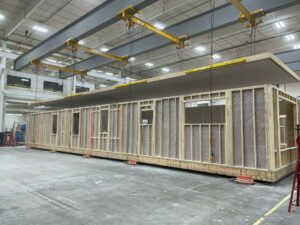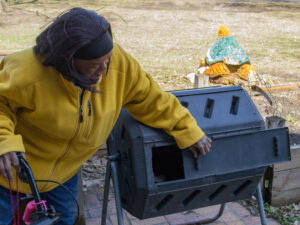Every year, Earth Day stands to draw attention to how the planet should be cared for. At MPHA, the focus on environmental sustainability is woven into much of the agency’s work. This includes renewable energy sources in its new developments, electrifying its maintenance operations where possible, supporting MPHA resident community gardens, and incorporating energy efficient upgrades in building renovations.
 Building Green with the Family Housing Expansion Project
Building Green with the Family Housing Expansion Project
Celebrating its groundbreaking earlier this year, the Family Housing Expansion Project (FHEP) will provide more than just homes to families, it also provides MPHA a blueprint to deliver more sustainable, green housing. This new project incorporates modular design, solar energy use, and a variety of other energy efficiency, health, and green measures to meet the Minnesota Enterprise Green Communities criteria. Using modular building design, the structures are mostly built in a manufacturing facility rather than on-site, reducing building project waste.
Additionally, each building is equipped with a 22.6 kW solar system, generating enough energy to cover an estimated 30 percent of the buildings’ electrical usage through this renewable source. Across all sites, this 361.6 kW solar system could be likened to avoiding the burning of 335,000 pounds of coal for a whole year!
Working Green with Electric Equipment
Leading the MPHA AMP 7 maintenance team in Central and South Minneapolis, Robert Anderson and his team have been switching out their old gas-powered equipment for new, battery-powered tools. With the help of an alternative landscaping equipment grant from Hennepin County, the agency was able to make a larger investment in these new tools initially.
Since then, Robert’s team has been gradually replacing the remaining gas-powered devices like lawn mowers, hedge trimmers, snow blowers, leaf blowers, and chainsaws. Making this change has great benefits for the environment and MPHA: eliminating fuel costs and emissions, reduces necessary equipment maintenance, and makes the equipment lighter for the operator and quieter for residents.
Living Green with Resident Gardens
 Each year, MPHA residents plant and care for gardens full of vegetables and flowers. No matter the garden size, MPHA residents make the most out of the space and the result is a joy to all those around.
Each year, MPHA residents plant and care for gardens full of vegetables and flowers. No matter the garden size, MPHA residents make the most out of the space and the result is a joy to all those around.
Angerline Goodwin has been a part of Hamilton Manor’s gardening group since its inception more than a decade ago. Through a partnership with the University of Minnesota agricultural department, Angerline and other residents have learned all about horticulture, hydroponics, and vegetable harvesting. Angerline attributes her knowledge to the teaching of the University of Minnesota students, while explaining the transformation a plant undergoes from seed to seedling to budding and so on. Her passion for the building’s garden and love for tending the soil is palpable.
 “I like to watch the garden grow. I like being with the neighbors, being outside, and just learning how to garden,” said Angerline.
“I like to watch the garden grow. I like being with the neighbors, being outside, and just learning how to garden,” said Angerline.
Similarly, Shirley Vincent knows how much a glimpse of colorful flowers can brighten someone’s day at Heritage Commons. Shirley has helped liven up the gardens and patios with flowers for the past 15 years she’s lived there. Each year she adds new containers housing new budding varieties through a partnership with Minnesota Green. The Heritage Commons plantings are mostly foliage and flowering types rather than vegetables, providing a colorful setting for residents to enjoy the outdoors.
“I love working in the dirt,” said Shirley. “I love watching the flowers grow.”
Renovating Green with the Elliot Twins
Last summer, MPHA completed a historic $27 million renovation of the 60-year-old Elliot Twins, improving accessibility, replacing aging building systems, and completing energy efficiency improvements. These green improvements included exterior insulation with metal cladding over the existing brick façade, new windows, new roofing, appliances, and lighting and controls, among other upgrades. These changes reduce heating and cooling expenses along with an overall reduction in energy usage. Additionally, new raised garden boxes, stormwater system and landscaping add value for residents and the local ecosystem.
These are just a few ways MPHA and its residents are stewarding the local environment and reducing its carbon footprint.



